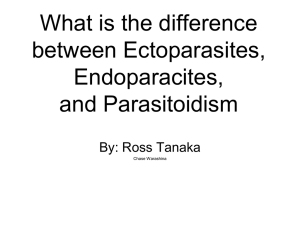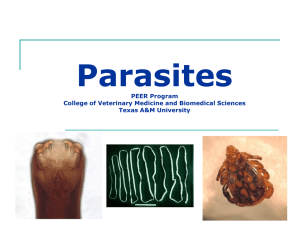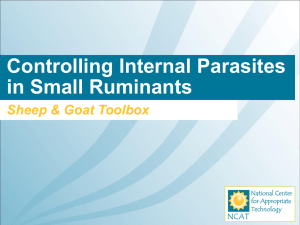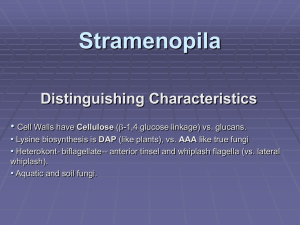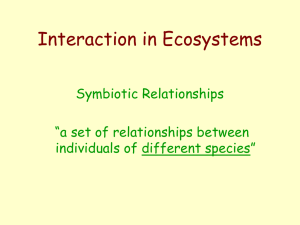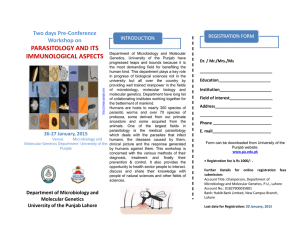Impact of Parasites on Animal Health
advertisement
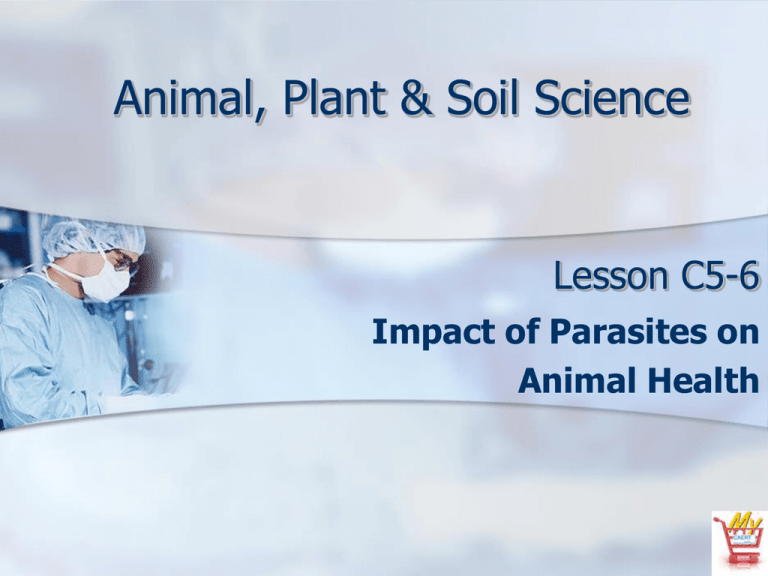
Animal, Plant & Soil Science Lesson C5-6 Impact of Parasites on Animal Health Objectives Identify common internal and external parasites that affect livestock and companion animals, and describe the diseases that they may spread or cause. Objectives Diagram and describe the complete life cycle of common parasites that affect animals. Recognize the importance of controlling parasites, and describe methods used to control parasites in disease management. What are the common internal and external parasites that affect livestock and companion animals, and what diseases might they spread or cause? Internal parasites and external parasites A. Internal parasites live within the host’s body or organs. 1. Livestock refers to domestic animals that are owned and raised as stock (e.g., cattle, sheep, and swine). What are the common internal and external parasites that affect livestock and companion animals, and what diseases might they spread or cause? a. Several species of stomach worms affect livestock. The most common stomach worms are barber pole worms (Haemonchus spp.), brown stomach worms (Ostertagia ostertagi), and small stomach worms (Trichostrongylus axei). Each species affects herds differently based on climate, nutrition, immune status, rainfall, and conditions (e.g., overcrowding and overgrazing, which increase the harmfulness). What are the common internal and external parasites that affect livestock and companion animals, and what diseases might they spread or cause? b. Animals infected with an average number of worms can reduce weight gains by 10 to 20 percent. The economic losses are greatest in growing calves, yet the sheep and goat industry is severely threatened by barber pole worms because they are resistant to almost every available de-wormer. These infections cause severe blood loss, resulting in death loss on many farms. Treatment is difficult after the sheep or goats have become anemic (a deficiency in red blood cells). What are the common internal and external parasites that affect livestock and companion animals, and what diseases might they spread or cause? 2. Companion animals (e.g., dogs, cats, and rabbits) have special bonds with humans, known as the human-animal bond. A mutual affection is present. a. Heartworms are thin, string-like parasites that reach the adult stage in the chambers of the host’s heart and obstruct major arteries, causing heart failure and death in the host, if untreated. b. Heartworms are transmitted from an infected host to an uninfected host by mosquitoes that carry the parasite. What are the common internal and external parasites that affect livestock and companion animals, and what diseases might they spread or cause? B. External parasites are found on the outside of the host (e.g., on the skin or in the hair). 1. Livestock a. Horn flies (Haematobia irritans) are blood feeders that primarily target cattle kept on pasture. The flies pierce the skin with their short, tubelike mouthparts approximately 20 to 30 times per day to ingest small amounts of blood. What are the common internal and external parasites that affect livestock and companion animals, and what diseases might they spread or cause? b. Horn flies can be annoying to the cattle and the farmer. Every year, horn flies cause great economic losses due to reductions in weight gain. What are the common internal and external parasites that affect livestock and companion animals, and what diseases might they spread or cause? 2. Companion animals a. Fleas are a common external parasite of pets, specifically the cat flea (Ctenocephalides felis) and the dog flea (Ctenocephalides canis). b. Cat fleas can be irritating when they bite humans and pets. They can cause pets to develop flea allergies. Female cat fleas feed on the animal’s blood and live on the host until they die, are consumed during grooming, or are killed by insecticides. What are the common internal and external parasites that affect livestock and companion animals, and what diseases might they spread or cause? c. Fleas can live anywhere (inside or outside), but they prefer to avoid direct light by hiding in the carpet, under furniture, under leaves, or in the soil. d. In addition to causing irritation to pets, fleas can carry diseases (e.g., the Black Plaque was transmitted by the rat flea in the 1300s). scratch fever (Bartonella henselae) is a disease that is carried by fleas today. Cat What are the common internal and external parasites that affect livestock and companion animals, and what diseases might they spread or cause? C. Diseases caused by parasites 1. Stomach worms a. If stomach worms are not adequately treated, they can lead to the disease called bottlejaw. This occurs when animals have heavy worm burdens and start to lose protein from their intestines, causing fluid to build up in the skin under their jaws and lower abdomen. Other signs of stomach worms are weight loss, rough hair coat, weakness, and anorexia (a loss of appetite). What are the common internal and external parasites that affect livestock and companion animals, and what diseases might they spread or cause? b. Cattle that are overcrowded will have a lower immune system, making them more susceptible to bottlejaw. What are the common internal and external parasites that affect livestock and companion animals, and what diseases might they spread or cause? 2. Heartworms a. If preventative measures are not taken, animals can eventually die from heartworm disease. b. Heartworm disease can be detected, in most cases, by a blood test performed in the vet clinic. Evidence of heart damage can be observed on X-rays if it is severe and chronic. What are the common internal and external parasites that affect livestock and companion animals, and what diseases might they spread or cause? c. Signs of a heartworm infection are blood vessel obstruction, coughing (resulting from fluid build-up due to heart failure), shortness of breath, and lethargy. However, some dogs do not show signs until the disease is advanced. While dogs can tolerate many heartworms, cats can die instantly from a single heartworm becoming lodged in a heart vessel. What are the common internal and external parasites that affect livestock and companion animals, and what diseases might they spread or cause? 3. Horn flies a. Horn flies do not specifically cause a disease, but a large amount of horn flies can cause weight loss due to aggravation. They cause extreme discomfort, irritation, and itching. b. Horn flies serve as the intermediate host for a parasite called Stephanofilariasis, which causes common plaque-like lesions on the underside of the abdomen. What are the common internal and external parasites that affect livestock and companion animals, and what diseases might they spread or cause? 4. Fleas a. If pets ingest fleas while grooming, they can develop tapeworms. These pests can cause weight loss, if left untreated. b. In addition, some pets become allergic to flea saliva, causing them to scratch continuously. As a result, they may lose all of their hair over time. Fleas can also cause skin infections called “hot spots.” c. Extreme flea infestations on young animals can cause them to develop anemia. How do you diagram the complete life cycle of common parasites that affect animals? What are the life cycles of common parasites that affect animals? The life cycle refers to the changes in form that an organism goes through from birth to death. A. Stomach worms 1. Stomach worms go through complete metamorphosis: egg, pupa, larva, and adult. How do you diagram the complete life cycle of common parasites that affect animals? What are the life cycles of common parasites that affect animals? 2. Egg are passed to the ground in the form of manure. The eggs hatch in the manure, and they are washed into the grass by the rain. The livestock eat the grass and accidentally ingest the larvae. 3. While in the intestinal tract and stomach, the larvae develop into adults and lay eggs in the stomach lining. How do you diagram the complete life cycle of common parasites that affect animals? What are the life cycles of common parasites that affect animals? B. Heartworms 1. A mosquito bites an animal already infected with heartworm microfilaria in its blood. As a result, the mosquito becomes infected. Microfilaria are basically baby worms. 2. The microfilaria enter the larval stage while in the mosquito. How do you diagram the complete life cycle of common parasites that affect animals? What are the life cycles of common parasites that affect animals? 3. The mosquito passes the larvae to a healthy dog while ingesting blood during a meal. The larvae then migrate through the tissues of the animal, eventually reaching the heart. 4. Heartworms can grow up to 12 inches long during the adult stage. How do you diagram the complete life cycle of common parasites that affect animals? What are the life cycles of common parasites that affect animals? C. Horn flies 1. Female horn flies lay their eggs in manure. Within a few minutes after the eggs have been deposited, the pupae stage begins. Then they develop into larvae. Finally, wings develop during the adult stage, and horn flies begin to irritate the livestock. 2. The horn fly life cycle is completed in approximately 10 to 14 days, and each female can lay up to 500 eggs. How do you diagram the complete life cycle of common parasites that affect animals? What are the life cycles of common parasites that affect animals? D. Fleas 1. The female flea mates soon after consuming a blood meal. She can lay 40 to 50 eggs per day on the host. How do you diagram the complete life cycle of common parasites that affect animals? What are the life cycles of common parasites that affect animals? 2. The eggs fall off the host onto the carpet or ground and hatch in one to six days. The larvae feed on dead skin cells, other organic debris, and the feces from the adult fleas. The larvae become mature in 5 to 11 days and then form cocoons as they enter the pupae stage. In one to two weeks, the pupae hatch and adult fleas emerge. The adult fleas start feeding as soon as they find hosts. How do you diagram the complete life cycle of common parasites that affect animals? What are the life cycles of common parasites that affect animals? 3. The flea life cycle is usually completed in an average of three to six weeks, in average household conditions. However, the life cycle can be as quick as 12 to 14 days or as long as 350 days, depending on temperature and humidity. Why is it important to control parasites? What methods are used to control them? Parasite control refers to the preventative measures taken to reduce parasite numbers and to reduce the further spread of parasites. A. Livestock parasites 1. The best way to control stomach worm populations is through regular de-worming and good nutrition. Reducing overcrowding, minimizing overgrazing, and boosting immunity by having proper food additives, vitamins, and vaccinations will also help. Why is it important to control parasites? What methods are used to control them? 2. Horn flies a. One of the best ways to control horn flies throughout the season is to use selftreatment insecticides or routinely apply sprays or dust with insecticides. b. Ear tags (pyrethroid tags) that contain insecticide are also useful. These tags will successfully reduce the numbers of horn flies if the tags are used properly. Rotating the types of tags used every other year can help prevent resistance from developing. Why is it important to control parasites? What methods are used to control them? B. Companion animals 1. Heartworms a. Heartworms are easily prevented, if the proper measures are taken. Pets need a monthly heartworm pill. b. Most puppies are started on monthly heartworm treatments by the time they are eight weeks old. Why is it important to control parasites? What methods are used to control them? 2. Fleas a. Fleas can be controlled by topical insecticides (that help kill fleas) applied once per month to the skin. These insecticides stop the life cycle and repel fleas. In addition, treating the environment (e.g., the yard, the pet’s bedding, and the household carpet and furniture) is important. Why is it important to control parasites? What methods are used to control them? b. Flea dips and baths are not very effective. They were once popular. However, as soon as the pets are dry, the adult fleas in the environment can immediately reinfect the pets. Review What are the common internal and external parasites that affect livestock and companion animals, and what diseases might they spread or cause? Review How do you diagram the complete life cycle of common parasites that affect animals? What are the life cycles of common parasites that affect animals? Why is it important to control parasites? What methods are used to control them?
